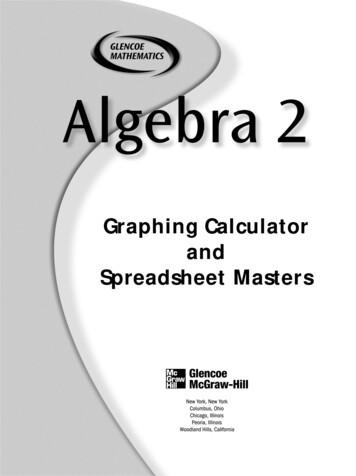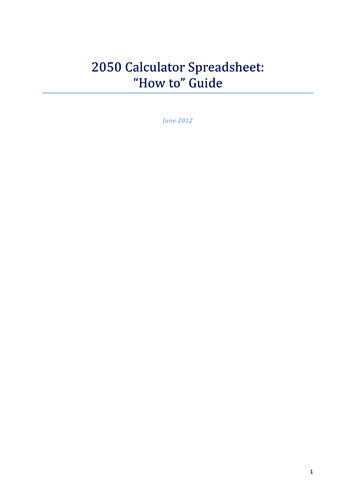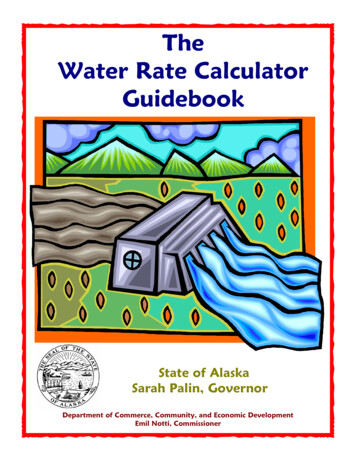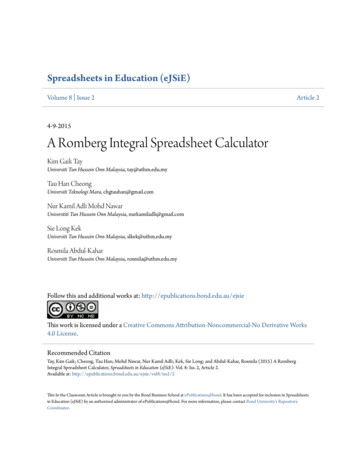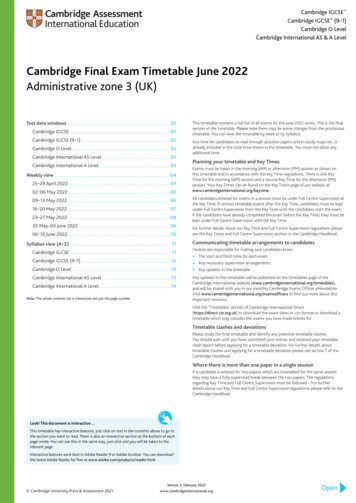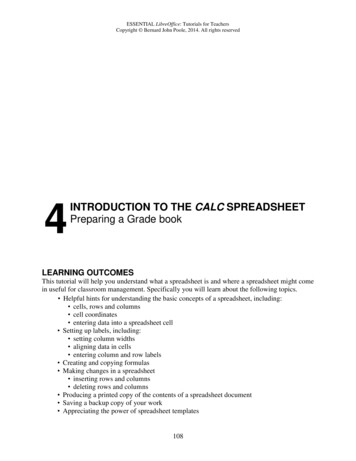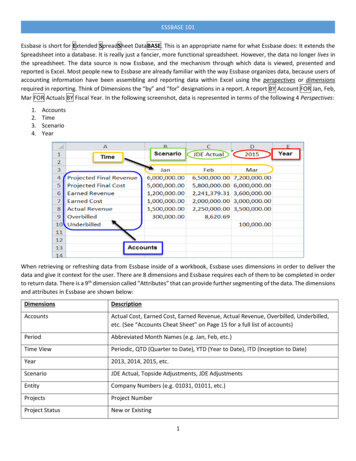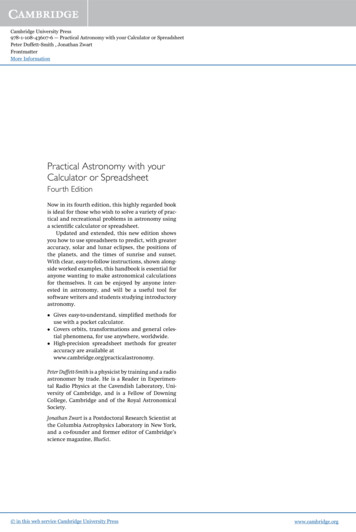
Transcription
Cambridge University Press978-1-108-43607-6 — Practical Astronomy with your Calculator or SpreadsheetPeter Duffett-Smith , Jonathan ZwartFrontmatterMore InformationPractical Astronomy with yourCalculator or SpreadsheetFourth EditionNow in its fourth edition, this highly regarded bookis ideal for those who wish to solve a variety of practical and recreational problems in astronomy usinga scientific calculator or spreadsheet.Updated and extended, this new edition showsyou how to use spreadsheets to predict, with greateraccuracy, solar and lunar eclipses, the positions ofthe planets, and the times of sunrise and sunset.With clear, easy-to-follow instructions, shown alongside worked examples, this handbook is essential foranyone wanting to make astronomical calculationsfor themselves. It can be enjoyed by anyone interested in astronomy, and will be a useful tool forsoftware writers and students studying introductoryastronomy. Gives easy-to-understand, simplified methods foruse with a pocket calculator. Covers orbits, transformations and general celestial phenomena, for use anywhere, worldwide. High-precision spreadsheet methods for greateraccuracy are available atwww.cambridge.org/practicalastronomy.Peter Duffett-Smith is a physicist by training and a radioastronomer by trade. He is a Reader in Experimental Radio Physics at the Cavendish Laboratory, University of Cambridge, and is a Fellow of DowningCollege, Cambridge and of the Royal AstronomicalSociety.Jonathan Zwart is a Postdoctoral Research Scientist atthe Columbia Astrophysics Laboratory in New York,and a co-founder and former editor of Cambridge’sscience magazine, BlueSci. in this web service Cambridge University Presswww.cambridge.org
Cambridge University Press978-1-108-43607-6 — Practical Astronomy with your Calculator or SpreadsheetPeter Duffett-Smith , Jonathan ZwartFrontmatterMore InformationPractical Astronomy with yourCalculator or SpreadsheetFourth EditionPeter Duffett-SmithDowning College, CambridgeJonathan ZwartColumbia University in the City of New York in this web service Cambridge University Presswww.cambridge.org
Cambridge University Press978-1-108-43607-6 — Practical Astronomy with your Calculator or SpreadsheetPeter Duffett-Smith , Jonathan ZwartFrontmatterMore InformationUniversity Printing House, Cambridge CB2 8BS, United KingdomOne Liberty Plaza, 20th Floor, New York, NY 10006, USA477 Williamstown Road, Port Melbourne, VIC 3207, Australia4843/24, 2nd Floor, Ansari Road, Daryaganj, Delhi - 110002, India79 Anson Road, #06-04/06, Singapore 079906Cambridge University Press is part of the University of Cambridge.It furthers the University’s mission by disseminating knowledge in the pursuit ofeducation, learning and research at the highest international levels of excellence.www.cambridge.orgInformation on this title: www.cambridge.org/9781108436076 Cambridge University Press 1979, 1982, 1989 Peter Duffett-Smith and Jonathan Zwart 2011This publication is in copyright. Subject to statutory exceptionand to the provisions of relevant collective licensing agreements,no reproduction of any part may take place without the writtenpermission of Cambridge University Press.First published 1979Second edition 1982Third edition 1989Fourth edition 20115th printing 2016First paperback edition 2017A catalogue record for this publication is available from the British LibraryLibrary of Congress Cataloging in Publication dataDuffett-Smith, Peter.Practical astronomy with your calculator or spreadsheet / Peter Duffett-Smith,Jonathan Zwart. – 4th ed.p. cm.Rev. ed. of: Practical astronomy with your calculator / Peter Duffett-Smith. 3rd ed. 1988.Includes bibliographical references and index.ISBN 978-0-521-14654-8 (pbk.)1. Astronomy – Problems, exercises, etc. 2. Calculators – Problems, exercises, etc.3. Electronic spreadsheets in education. I. Zwart, Jonathan. II. Duffett-Smith,Peter. Practical astronomy with your calculator. III. Title.QB62.5.D83 2011520.76 – dc222010041671ISBN 978-0-521-14654-8 HardbackISBN 978-1-108-43607-6 PaperbackAdditional resources for this publication at www.cambridge.org/practicalastronomyCambridge University Press has no responsibility for the persistence oraccuracy of URLs for external or third-party internet websites referred to inthis publication, and does not guarantee that any content on such websites is,or will remain, accurate or appropriate. in this web service Cambridge University Presswww.cambridge.org
Cambridge University Press978-1-108-43607-6 — Practical Astronomy with your Calculator or SpreadsheetPeter Duffett-Smith , Jonathan ZwartFrontmatterMore InformationTo our friends andcolleagues at MRAO in this web service Cambridge University Presswww.cambridge.org
Cambridge University Press978-1-108-43607-6 — Practical Astronomy with your Calculator or SpreadsheetPeter Duffett-Smith , Jonathan ZwartFrontmatterMore InformationContentsPreface to the fourth editionAbout this book and how to use itA word about spreadsheets – what are they?The layout of spreadsheets in this bookCalculations involving multiple sheetsUsing our own functionspage ndarsThe date of EasterConverting the date to the day numberJulian datesConverting the Julian date to the Greenwich calendar dateFinding the name of the day of the weekConverting hours, minutes and seconds to decimal hoursConverting decimal hours to hours, minutes and secondsConverting the local time to universal time (UT)Converting UT and Greenwich calendar date to local time and dateSidereal time (ST)Conversion of UT to Greenwich sidereal time (GST)Conversion of GST to UTLocal sidereal time (LST)Converting LST to GSTEphemeris time (ET) and terrestrial time rdinate systemsHorizon coordinatesEquatorial coordinatesEcliptic coordinatesGalactic coordinatesConverting between decimal degrees and degrees, minutes and secondsConverting between angles expressed in degrees and angles expressed in hoursConverting between one coordinate system and another3334353738394142vii in this web service Cambridge University Presswww.cambridge.org
Cambridge University Press978-1-108-43607-6 — Practical Astronomy with your Calculator or SpreadsheetPeter Duffett-Smith , Jonathan ZwartFrontmatterMore 7383940414243Converting between right ascension and hour angleEquatorial to horizon coordinate conversionHorizon to equatorial coordinate conversionEcliptic to equatorial coordinate conversionEquatorial to ecliptic coordinate conversionEquatorial to galactic coordinate conversionGalactic to equatorial coordinate conversionGeneralised coordinate transformationsThe angle between two celestial objectsRising and ntric parallax and the figure of the EarthCalculating corrections for parallaxHeliographic coordinatesCarrington rotation numbersSelenographic coordinatesAtmospheric extinction444546474849505152The SunOrbitsThe apparent orbit of the SunCalculating the position of the SunCalculating orbits more preciselyCalculating the Sun’s distance and angular sizeSunrise and sunsetTwilightThe equation of timeSolar 7585960616263The planets, comets and binary starsThe planetary orbitsCalculating the coordinates of a planetFinding the approximate positions of the planetsPerturbations in a planet’s orbitThe distance, light-travel time and angular size of a planetThe phases of the planetsThe position-angle of the bright limbThe apparent brightness of a planetCometsParabolic orbitsBinary-star orbits119120121131132136137138140143151155 in this web service Cambridge University ambridge.org
Cambridge University Press978-1-108-43607-6 — Practical Astronomy with your Calculator or SpreadsheetPeter Duffett-Smith , Jonathan ZwartFrontmatterMore InformationContents646566676869707172737475ixThe Moon and eclipsesThe Moon’s orbitCalculating the Moon’s positionThe Moon’s hourly motionsThe phases of the MoonThe position-angle of the Moon’s bright limbThe Moon’s distance, angular size and horizontal parallaxMoonrise and moonsetEclipsesThe ‘rules’ of eclipsesCalculating a lunar eclipseCalculating a solar eclipseThe Astronomical ssary of termsSymbols and abbreviationsBibliographyA useful websiteIndex197205208209210 in this web service Cambridge University Presswww.cambridge.org
Cambridge University Press978-1-108-43607-6 — Practical Astronomy with your Calculator or SpreadsheetPeter Duffett-Smith , Jonathan ZwartFrontmatterMore InformationPreface to the fourth editionPractical Astronomy with your Calculator or Spreadsheet has been written for those who wish to calculatethe positions and visual aspects of the major heavenly bodies and important phenomena such as eclipses, either for practical purposes or simply because they enjoy making predictions. We present recipes for makingcalculations, where we have cut a path through the complexities and difficult concepts of rigorous mathematics, taking account only of those factors that are essential to each calculation and ignoring correctionsfor this and that, necessary only for very precise predictions of astronomical phenomena. Our simple methods, suitable for use with a pocket calculator, are usually sufficient for all but the most exacting amateurastronomer, but they should not be used for navigational purposes. For example, the times of sunrise andsunset can be determined to within 1 minute and the position of the Moon to within one fifth of a degree.But new to this fourth edition are spreadsheets which offer much higher precision (see below).The second edition included much more material in response to letters and requests from readers of thefirst edition. Many errors were also corrected. The third edition continued the same process, adding fournew sections on generalised coordinate transformations, nutation, aberration and selenographic coordinates,improving the sunrise/set and moonrise/set calculations so that they worked properly everywhere in theworld, including a rigorous method of calculating precession, taking account of the J2000 astronomicalsystem where appropriate, and correcting mistakes or clarifying obscurities wherever they were found inthe second edition.The fourth edition has also been updated considerably; however the major change is that we have included, for the first time, a spreadsheet for nearly every calculation. Each spreadsheet illustrates the calculation, making it easier to get the right answer. But we have also written a library of powerful functionswhich can carry out many of the calculations for you with much higher precision, so those people who wishto use their computers can do so and obtain the benefits of greater accuracy. For example, use the simplerecipes and your calculator to find the times of moonrise and moonset to within a precision of 10 minutesor so, or use the spreadsheet functions to obtain the results correct to within 1 minute. You will need tovisit our website (see page 209) to download the spreadsheets to your computer; the library of functionswill come automatically with the spreadsheets.We are most grateful to those kind people who have taken the trouble to write in with their suggestions,criticisms and corrections, in particular to Mr E. R. Wood, who kindly scanned the manuscript of thethird edition for errors, Mr S. Hatch, Mr S. J. Garvey, who supplied the nomogram for the solution ofKepler’s equation, and Mr Anthony Ehrlich of Pittsburgh, Pennsylvania, who developed a rudimentaryscheme for calculating the circumstances of sunrise/set and moonrise/set into one that actually workedxi in this web service Cambridge University Presswww.cambridge.org
Cambridge University Press978-1-108-43607-6 — Practical Astronomy with your Calculator or SpreadsheetPeter Duffett-Smith , Jonathan ZwartFrontmatterMore InformationxiiPreface(superseded in this edition). We would also like to thank and acknowledge those authors whose books wehave read and whose ideas we have cribbed, mentioning particularly Jean Meeus (Astronomical Formulaefor Calculators) and W. Schroeder (Practical Astronomy). We have made extensive use of The ExplanatorySupplement to the Astronomical Ephemeris and the American Ephemeris and Nautical Almanac, as well asthe Astronomical Almanac and its predecessors.Our thanks are also due to Dr Anthony Winter, who suggested writing the first edition of the book, toMrs Dunn who typed it, to Dr Guy Pooley who read the manuscript and made many helpful suggestions,and to Dr Simon Mitton for taking so much trouble over the production of the book. Thanks for particularhelp with the fourth edition go to William Lancaster, Sehar Tahir and our editor Vince Higgs.We are most grateful to Gary Barnes, Allan Bell, Markus Böhm, Michael Coren, Mike Dworetsky, ErrolGlaze, Greg Halac, Ilja Heckmann, John Horsman, Stuart Lowe, Henry Nilsson, Graham Relf, J. Sapranidisand Mike Trace for spotting errors in the initial versions of the text and in the spreadsheets and theirfunctions.We hope you have as much fun with these recipes and spreadsheets as we have had! Please let us knowwhen you find an error. You can contact us via the book’s website (see page 209). in this web service Cambridge University Presswww.cambridge.org
Cambridge University Press978-1-108-43607-6 — Practical Astronomy with your Calculator or SpreadsheetPeter Duffett-Smith , Jonathan ZwartFrontmatterMore InformationAbout this book and how to use itHow many times have you said to yourself, ‘I wonder whether I can see Mercury this month?’ or ‘Whatwill be the phase of the Moon next Tuesday?’ or even ‘Will I be able to see the solar eclipse in Boston?’Perhaps you could turn to your local newspaper to find the information, or go down to your local libraryto consult the Astronomical Almanac. You may even have an astronomical journal containing the requiredinformation, or perhaps some computer software or a website that might do the trick. But you wouldnot, we suspect, think of sitting down and calculating it for yourself. Yet even though you may not findmathematics particularly transparent, you can still do this for yourself. You can quite easily find the answerto many astronomical questions using this book of calculation recipes. You use it just as you would a recipebook in the kitchen – follow the recipe and produce a delicious dish! All you need in addition is a calculator,a piece of paper, a ruler and a pencil. (For those of us with access to a computer, we can use that instead ofthe calculator and carry out all the calculations in a spreadsheet program as further described below.)Your calculator does not have to be a very sophisticated device costing a great deal of money; on theother hand it should be a little better than a basic four-function machine. At a minimum, it must havebuttons for the trigonometric functions sine, cosine and tangent. It should also be able to find squareroots and logarithms. Such calculators generally describe themselves as ‘scientific calculators’. Featuresother than these are not essential but can make the calculations easier. For example, having a number ofseparately-addressable memories in which you can store intermediate results would be useful. If you have aprogrammable calculator, you can write programs to carry out many of the calculations automatically witha subsequent saving of time and effort.When choosing a calculator, don’t be led astray by arguments about whether ‘reverse Polish notation’(RPN) or ‘algebraic notation’ (AN) is the better system. Each has its advantages and the same complexityof calculation may be made using either. It is important, however, to read the instructions carefully andto get to know your calculator thoroughly, whatever system it uses. Make sure that you like the ‘feel’ ofthe keypad, and that pressing a key once results in just one digit appearing in the display. Look out forspecial functions that can help you, like a key that gives you π (the constant 3.141 592 654), a key thatconverts between times or angles expressed as hours or degrees, minutes, and seconds, and their decimalequivalents, a key that takes any angle, positive or negative, and returns its equivalent value reduced tothe range 0 to 360 , and a key that converts between rectangular and polar coordinates (very useful forremoving the ambiguity of 180 on taking the inverse tangent of an angle).When you go through the worked examples given with each calculation, do not be alarmed if yourfigures do not match ours exactly. There are several reasons why they may not, including rounding errorsxiii in this web service Cambridge University Presswww.cambridge.org
Cambridge University Press978-1-108-43607-6 — Practical Astronomy with your Calculator or SpreadsheetPeter Duffett-Smith , Jonathan ZwartFrontmatterMore InformationxivAbout this book and how to use itand misprints. You should try to work with at least seven or eight significant figures. If you write yourown programs to carry out any of the calculations on a computer, make sure that you use variables havingsufficient resolution. Use double precision (eight-byte precision) everywhere if possible.Having gathered together your writing materials, calculator and book, how do you proceed? Let us takeas an example the problem of finding the time of sunrise. Turn to the index and look up ‘sunrise’; you aredirected to page 112 where you will find a paragraph or two of explanation and a list of instructions witha worked example in the form of a table. We have kept things brief on purpose and have made no attemptto provide mathematical derivations. We have also simplified the calculations. As you work through eachstep, write down the step number and the result in a methodical fashion. Take care here and it will save youa lot of time later!Many calculations require you to turn back and forth between different sections. For example, step 1 of‘sunrise’ directs you to another section to calculate the position of the Sun. Make the calculations in thatsection, and then turn back to carry on with step 2. You will find it useful to keep several slips of paperhandy as bookmarks.This book is not intended to match the precision of the results found in the Astronomical Almanac. As wehave already mentioned, the calculations have deliberately been simplified although they are good enoughfor most purposes. If you have your own computer, you can use the methods to write programs displayingthe evolving Solar System with a precision that is better than the resolution of the computer screen. Butthose of us with simple pocket calculators can find great satisfaction in simply being able to work out thestars for ourselves and to predict astronomical events with almost magical precision. in this web service Cambridge University Presswww.cambridge.org
Cambridge University Press978-1-108-43607-6 — Practical Astronomy with your Calculator or SpreadsheetPeter Duffett-Smith , Jonathan ZwartFrontmatterMore InformationA word about spreadsheets – what are they?In 1979, when the first edition of Practical Astronomy with your Calculator was published, very few peoplehad access to a computer. Although home computers were beginning to appear in the high street, they werenot the commonplace household accessory we see today. Calculations were made using a calculator, thesophistication of which ranged from the simple four-function device to the versatile programmable reversePolish scientific machine. You may already own a calculator that would be suitable for the recipes givenhere, but you might also own a computer and wish to make the calculations using that instead. If you aregood at programming, you could consider using the methods described in this book as a basis for writingyour own astronomical software. But most of us don’t want to embark on such a project. How then can weuse our computers to make astronomical calculations?One answer is to use a spreadsheet program such as Microsoft’s Excel, or OpenOffice Calc. The latteris available at no cost, and described as fully compatible with the former, so if you do not already own acommercial spreadsheet program, then Calc might be a good way to go. Once you have loaded the softwareon to your machine, open the spreadsheet program. The screen display should then look something likeFigure I. (Here and throughout the book, toolbars, sidebars and many other features have been removedfrom the spreadsheet views.)Figure I. An empty spreadsheet.xv in this web service Cambridge University Presswww.cambridge.org
Cambridge University Press978-1-108-43607-6 — Practical Astronomy with your Calculator or SpreadsheetPeter Duffett-Smith , Jonathan ZwartFrontmatterMore InformationxviA word about spreadsheets – what are they?Figure II. Cell C5 carries the number 23.9, and cell D5 carries the label This is a number.The spreadsheet consists of an array of cells, labelled A, B, C etc. across the top (these are the columnlabels) and 1, 2, 3 etc. down the left-hand side (these are the row labels). Each individual cell is labelled byits column letter and its row number, e.g. A1, B25 etc. The cell with the thick border around it in Figure Iis cell C5. You can write some text or numbers in any cell. In Figure II, the number 23.9 has been placedin cell C5, and the label This is a number has been placed in cell D5. (Since cell E5 is empty, the programhas allowed the label to overwrite the space allocated to E5, although the entire content This is a numberremains in D5, and E5 remains empty.) The spreadsheet knows that something placed in a cell is a label(i.e. text) if you begin the entry with a single apostrophe symbol ('). If you want to enter a number as anumber, just type it in. If you want the spreadsheet to treat the number as a label, put the apostrophe in frontof it.We can obviously put labels and numbers in any of the cells, but the real power of the spreadsheet comesfrom using formulas. A formula is a calculation which can use the contents of other cells. The result ofthe calculation is displayed in the cell carrying the formula, so you are not usually aware of the calculationthat has gone on in the background since what is displayed is the result rather than the formula itself. Aformula is placed in a cell by typing the equals sign ( ) followed by the formula. The spreadsheet knowsfrom the equals sign that it is to calculate the formula and display the result. For example, in Figure III, cellC6 carries the entry C5*C5. You will see that C6 now displays the result of multiplying the number in cellC5 by itself (the star symbol * means ‘multiply’), i.e. the square of the number 23.9, which is the number571.21. We have also placed the label This is its square in cell D6. in this web service Cambridge University Presswww.cambridge.org
Cambridge University Press978-1-108-43607-6 — Practical Astronomy with your Calculator or SpreadsheetPeter Duffett-Smith , Jonathan ZwartFrontmatterMore InformationA word about spreadsheets – what are they?xviiFigure III. Cell C6 carries the formula C5*C5 and hence displays the square of 23.9.Let’s see what happens if now we change the number in cell C5 without making any other change to thespreadsheet. In Figure IV the number in C5 has been changed to the number 4.0 and, hey presto, the squareof 4 (i.e. 16) is displayed in cell C6. You can begin to see that complex calculations can be performed foryou automatically with a spreadsheet program. With the right formulas placed in order in the spreadsheet,the results can be calculated for any set of starting values. That is just what we want to do in this book. Wecan hide the complications of the calculation of, say, the time of sunrise within the formulas and just entera date and geographical location in the correct cells at the top to obtain the result immediately.Figure IV. Cell C5 now carries the number 4 and so cell C6 displays the number 4 multiplied by 4 which is 16.We don’t need to explain much more about spreadsheets here, although we will note various techniquesas we go along. If you want to learn more about their powerful capabilities we suggest buying a book aboutspreadsheets (see the Bibliography on page 208 for a suggestion). In this book, we have supplied you withthe spreadsheet and formulas for most calculations, so all you have to do is to type in the labels, numbersand formulas as shown. The spreadsheet will then do its work automatically and give you the answer for in this web service Cambridge University Presswww.cambridge.org
Cambridge University Press978-1-108-43607-6 — Practical Astronomy with your Calculator or SpreadsheetPeter Duffett-Smith , Jonathan ZwartFrontmatterMore InformationxviiiA word about spreadsheets – what are they?any starting values you enter. (We have provided the spreadsheets ready-made on our website. Please lookin the section “A useful website” on page 209 for details.)The layout of spreadsheets in this bookAll of the spreadsheets in this book conform to the same general format (see Figure V). At the top, in cellA1, is the title of the spreadsheet (in this case Converting decimal hours to hours, minutes and seconds). Itis best to use a slightly larger font size for this and to make it boldface as here. We have used Arial 16 pointfor the title. Row number 2 is left blank (i.e. none of the cells has anything in it). In row 3, we have writtenthe label Input in A3 (Times New Roman font, italic face, 10 point) to remind us that the input values forthe spreadsheet are entered to the right of this cell. In the case shown in Figure V, there is only one inputvalue, the decimal hours (name label in B3, Arial font, bold face, 14 point), and it is entered in cell C3 (alsoArial font, bold face, 14 point). In spreadsheets which have more than one input value, the others have theirname labels in cells B4, B5 etc. and their corresponding values in C4, C5 etc.Input nameInput valueStep numbersSpreadsheet titleOutput namesOutput valuesFormula resultsVariable namesThe formulas in the adjacent cells to the leftFigure V. The layout of a spreadsheet.The results of the calculations, i.e. the output values, are provided to the right of cell F3. We have writtenthe label Output in F3 (Times New Roman font, italic face, 10 point) to remind us that the output valuescalculated by the spreadsheet appear to the right of this cell. In the case shown in Figure V there are threeoutput values, called hours, minutes, seconds. Their name labels appear in cells G3, G4, G5 (Arial font,bold face, 14 point) and their values in H3, H4, H5 (also Arial font, bold face, 14 point) respectively. Justto the right of the three output values, in column I, are shown the formulas (written as labels, i.e. with an in this web service Cambridge University Presswww.cambridge.org
Cambridge University Press978-1-108-43607-6 — Practical Astronomy with your Calculator or SpreadsheetPeter Duffett-Smith , Jonathan ZwartFrontmatterMore InformationCalculations involving multiple sheetsxixapostrophe in front of the equals sign to stop the program calculating the formula) that are actually in theoutput value cells. Thus cell H3 actually contains the formula C14 (i.e. it will display the value of the cellC14) and you will need to enter C14 in the cell H3. Wherever you see a formula (anything beginning withthe equals sign) enter exactly that formula in the cell immediately to its left. In this case you would put C14 in cell H3, C12 in cell H4, and C10 in cell H5.The calculations carried out by the spreadsheet begin on row 7 in Figure V. Each row corresponds to onestep in the calculation, in this case the calculation method of Section 8. In the method table shown in thatsection there are just two steps, whereas in the spreadsheet there are eight. There is only a rough correspondence between method steps and spreadsheet steps. This is partly because the spreadsheet calculations donot have the benefit of human intelligence to assist them! For example, if you used your calculator to carryout the steps of Section 8, and you found that the result was, say, 6h 35m 60s, you would automaticallywrite this as 6h 36m 0s. The spreadsheet would, however, quite happily report the result in the first format.We get over the problem in the spreadsheet by first stripping out the sign, then converting to seconds, thenfinding the seconds, minutes and hours in that order, and finally putting back the sign.In the example shown in Figure V, you would enter the labels and formulas exactly as shown. Thuson row 7 you place the label '1 in A7 (this is text, and the apostrophe tells the spreadsheet so), the label'unsigned decimal in B7 and the formula in C7 shown immediately to its right, i.e. ABS(C3). Do this foreach calculation row (7 to 14 in this case). Finally, rename the spreadsheet on the tab at the bottom (DHHMSin this case). (You can probably do this by pointing at it with the mouse, pressing the right-hand mousebutton, and selecting the ‘rename’ option.)Although the labels in columns A and B make no difference to the calculations, we recommend that youput them in as they make the spreadsheet much easier to understand. This becomes more important if youreturn to a spreadsheet some time after you constructed it.One other note about spreadsheets that you might find useful concerns column widths. If the columnwidth is too narrow to display the content of a cell, you may just see something like ######## displayedinstead. You can adjust the column width by placing the mouse pointer on the division between the label(A, B, C etc.) of the column you want to alter and the label of the column immediately to its right, holdingdown the left-hand mouse button, and ‘dragging’ the column width left or right
Calculator or Spreadsheet Fourth Edition Now in its fourth edition, this highly regarded book is ideal for those who wish to solve a variety of prac-tical and recreational problems in astronomy using a scienti c calculator or spreadsheet. Updated and extended, this new edition shows you how to use spreadsheets to predict, with greater

